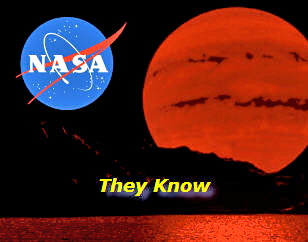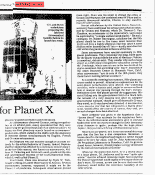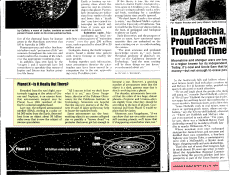|

by Marshall Masters
YOWUSA.COM, 12-August-07
Update 13-August-2007
from
Yowusa Website
 When
discussing Planet X, one inevitably encounters this knee-jerk rejectionist rant. When
discussing Planet X, one inevitably encounters this knee-jerk rejectionist rant.
"Well, if Planet X really did
exist, our government would tell us about it."
They have, so those of us who actively
research the topic ignore these rejectionist rants because we know
that they know.
However, for those of you who are new to the topic, or are trying to
discuss the subject with others, here are three undeniable speed
bumps you can toss under those fast-moving rejectionist rascals.
One of which, happens to be a smoking
gun!
#1 — NASA and Are
We Alone in the Universe?
In a 1992 video,
Zecharia Sitchin first
offered a revealing excerpt from a 1992 NASA press release.
The 'Are We Alone in the Universe?' video was originally
released in 1992 and was poorly re-mastered in 2003. The minute
you play it, you know it’s authentic because of Sitchin’s
typically wooden performance. Nonetheless, it is a treasure
trove for Planet X (Nibiru) researchers.
Towards the very end of the program, the following CGI text
appears, as though it were a last minute find, inserted during
the final edit.
NASA Press Release 1992
"Unexplained deviations in the orbits of Uranus and Neptune
point to a large outer solar system body of 4 to 8 Earth
masses, on a highly tilted orbit, beyond 7 billion miles
from the sun."
Sitchin is extremely precise in such
matters and this NASA quote is a bombshell. Nonetheless, we
vetted this so that we could use this quote in
Planet X Forecast and 2012 Survival Guide.
To do that, we started with a 2003 interview article on our site
by Steve Russell. In that interview Sitchin
states:
YOWUSA.COM, 01-June-02
Will Planet X / Nibiru Return in 2003?
“Some ten years ago the US Government itself, through its
Naval Observatory, led the search for "Planet X" and the
team's leader, Dr. Harrington, agreed with my ancient
evidence. At that time even The New York Times wrote that
all that is left regarding the existence of such a
post-Plutonian planet is to name it...
I have no doubt that at the right time — right in the eyes
of whoever decided these matters — the existence of Nibiru
will be officially confirmed.”
—Zecharia Sitchin
When discussing Planet X with
rejectionists, expect the Eris retort.
“Well they found it silly
and it’s called the Eris, the Tenth Planet.”
Ugh… there seems to
be this enduring misperception that this lifeless rock is the
Planet X / Nibiru that we’ve been looking for since the
discovery of Uranus. Wrong.
Eris object is slightly larger than Pluto and little better than
60% the size of our own moon. That means it has nowhere near
enough mass to be Planet X. Ergo, it was designated a dwarf
planet along with Pluto.
However, in fairness to this object, it really did get a bum
rap. It was originally named Xena in honor of a certain mega-hot
TV babe. Cool name, but now there’s this Eris renaming nonsense.
What’s with that: Revenge of the socially challenged astro-geeks,
part deux?
Back to Sitchin...
In Steve Russell’s interview, Sitchin refers to The New York
Times. Since he lives in New York, Sitchin follows that
newspaper with great interest, as do others.
One in particular is John DiNardo. A few days ago, he emailed me
two JPEG images (below images) of a 1983 article that appeared in the New York
Times. It turned out to be a wonderful bit of
synchronicity.
#2 — IRAS,
Planet X and the New York Times
On January 26, 1983, NASA launched the Infrared Astronomical
Satellite (IRAS) was launched on January 26, 1983. Independent
Planet X researchers have long held the idea that the IRAS
satellite imaged Planet X during its sky survey.
With that thought in mind, enjoy the following New York Times
article published just 4 days after the IRAS launch.
Clues Get Warm in the Search for Planet X
by John Noble Wilford
The New York Times
Sunday, January 30, 1983
Below images courtesy of John DiNardo:
 
Something out there beyond the
farthest reaches of the known solar system seems to be
tugging at Uranus and Neptune.
Some gravitational force
keeps perturbing the two giant planets, causing
irregularities in their orbits. The force suggests a
presence far away and unseen, a large object that may be the
long-sought Planet X.
Evidence assembled in recent years has led several groups of
astronomers to renew the search for the 10th planet. They
are devoting more time to visual observations with the
200-inch telescope at Mount Palomar in California. They are
tracking two Pioneer spacecraft, now approaching the orbit
of distant Pluto, to see if variations in their trajectories
provide clues to the source of the mysterious force. And
they are hoping that a satellite-borne telescope launched
last week will detect heat “signatures” from the planet, or
whatever it is out there.
The Infrared Astronomical Satellite was boosted into a
560-mile-high polar orbit Tuesday night from Vandenberg Air
Force Base, CA. It represents an $80-million venture by the
United States, Britain and the Netherlands. In the next six
or seven months, the telescope is expected to conduct a
wide-ranging survey of nearly all the sky, detecting sources
not of ordinary light, but of infrared radiation, which is
invisible to the human eye and largely absorbed by the
atmosphere.
Scientists thus hope that the new telescope will
chart thousands or infrared-emitting objects that have gone
undetected – stars, interstellar clouds, asteroids and, with
any luck, the object that pulls at Uranus and Neptune.
The last time a serious search of the skies was made, it led
to the discovery in 1930 of Pluto, the ninth planet. But the
story begins more than a century before that, after the
discovery of Uranus in 1781 by the English astronomer and
musician William Herschel. Until then, the planetary system
seemed to end with Saturn.
As astronomers observed Uranus, noting irregularities in its
orbital path, many speculated that they were witnessing the
gravitational pull of an unknown planet. So began the first
planetary search based on astronomers’ predictions, which
ended in the 1840’s with the discovery of Neptune almost
simultaneously by English, French and German astronomers.
But Neptune was not massive enough to account entirely for
the orbital behavior of Uranus. Indeed, Neptune itself
seemed to be affected by a still more remote planet. In the
late 19th century, two American astronomers, William H.
Pickering and Percival Lowell, predicted the size and
approximate location of the trans-Neptunian body, which
Lowell called Planet X.
Years later, Pluto was detected by Clyde W. Tombaugh working
at Lowell Observatory in Arizona. Several astronomers,
however, suspected it might not be the Planet X of
prediction. Subsequent observations proved them right. Pluto
was too small to change the orbits of Uranus and Neptune;
the combined mass of Pluto and its recently discovered
satellite, Charon, is only one-fifth that of Earth’s moon.
Recent calculations by the United States Naval Observatory
have confirmed the orbital perturbation exhibited by Uranus
and Neptune, which Dr. Thomas C. Van Flandern, an astronomer
at the observatory, says could be explained by “a single
undiscovered planet.”
He and a colleague, Dr.
Robert
Harrington, calculate that the 10th planet should be two to
five times more massive than Earth and have a highly
elliptical orbit that takes it some 5 billion miles beyond
that of Pluto – hardly next-door but still within the
gravitational influence of the Sun.
Some astronomers have reacted cautiously to the 10th-planet
predictions. They remember the long, futile quest for the
planet Vulcan inside the orbit of Mercury; Vulcan, it turned
out, did not exist. They wonder why such a large object as a
10th planet escaped the exhaustive survey by Mr. Tombaugh,
who is sure it is not in the two-thirds of the sky he
examined. But according to Dr. Ray T. Reynolds of the
Ames
Research Center in Mountain View, CA, other astronomers “are
so sure of the 10th planet, they think there’s nothing left
but to name it.”
At a scientific meeting last summer, 10th-planet partisans
tended to prevail. Alternative explanations for the
outer-planet perturbations were offered. The something out
there, some scientists said, might be an unseen black hole
or neutron star passing through the Sun’s vicinity.
Defenders of the 10th planet parried the suggestions.
Material falling into the gravitational field of a black
hole, the remains of a very massive star after its complete
gravitational collapse, should give off detectable x-rays,
they noted; no X-rays have been detected. A neutron star, a
less massive star that has collapsed to a highly dense
state, should affect the courses of comets, they said, yet
no such changes have been observed.
More credence was given to the hypothesis that a “brown
dwarf” star accounts for the mysterious force. This is the
informal name astronomers give to celestial bodies that were
not massive enough for their thermonuclear furnaces to
ignite; perhaps like the huge planet Jupiter, they just
missed being self-illuminating stars.
Most stars are paired, so it is not unreasonable to suggest
that the Sun has a dim companion. Moreover, a brown dwarf in
the neighborhood might not reflect enough light to be seen
far away, said Dr. John Anderson of the Jet Propulsion
Laboratory in Pasadena, CA. Its gravitational forces,
however, should produce energy detectable by the Infrared
Astronomical Satellite.
Whatever the mysterious force, be it a brown dwarf or a
large planet, Dr. Anderson said he was “quite optimistic”
that the infrared telescope might fine it and that the
Pioneer spacecraft could supply an estimate of the object’s
mass.
Of course, no one can be sure that even this discovery
would define the outermost boundary of the solar system.
Shortly after we posted this
article, John DiNardo must have toasted his library card to the
max, because he sent in another great clipping. Oh yah baby,
this is the one.
The smoking gun!
#3 — IRAS,
Planet X and the U.S.
News and World Report
A core premise of recent book, Planet X Forecast and 2012
Survival Guide is that Planet X is a brown dwarf.
'Dark
Star' Author, Andy Lloyd
who is a frequent guest on
Cut to the Chase, also
insists that Sol's companion in a brown dwarf.
Yowusa.com's stand in the matter is based on the detailed
historical accounts of previous Planet X flybys contained in
The
Kolbrin Bible. These prescient accounts of the
Egyptian and Celtic authors clearly describe a brown dwarf.
With that in mind, read this sidebar printed in the U.S. News
and World Report on 1984, detailing an early IRAS find.
U.S. News and World Report
September 10, 1984
Planet X — Is It Really Out There?
Below image courtesy of John DiNardo:

Shrouded from the sun's light,
mysteriously tugging at the orbits of Uranus and Neptune, is
an unseen force that astronomers suspect may be Planet X — a
10th resident of the Earth's celestial neighborhood.
Last year, the infrared astronomical satellite (IRAS),
circling in a polar orbit 560 miles from the Earth, detected
heat from an object about 50 billion miles away that is now
the subject of intense speculation.

"All I can say is that we don't
know what it is yet," says Gerry Neugebaur, director of the
Palomar Observatory for the California Institute of
Technology. Scientists are hopeful that the one-way journeys
of the Pioneer 10 and 11 space probes may help to locate the
nameless body.
Some astronomers say the heat-emitting object is an unseen
collapsed star or possibly a "brown dwarf" — a proto-star
that never got hot enough to become a star. However, a
growing number of astronomers insist that the object is a
dark, gaseous mass that is slowly evolving into a planet.
For decades, astronomers have noted that the orbits of two
huge, distant planets — Neptune and Uranus —deviate slightly
from what they should be according to the laws of physics.
Gravitational pull from Planet X would explain that
deviation.
"Morever," says Neugebaur, "if we can show that our own solar
system is still creating planets, we'll know that it's
happening around other stars, too."
The next time a knee-jerk
rejectionist rants on with "Well, if Planet X really did exist,
our government would tell us about it," you've got him by the
short hairs.
Happy tugging!
|